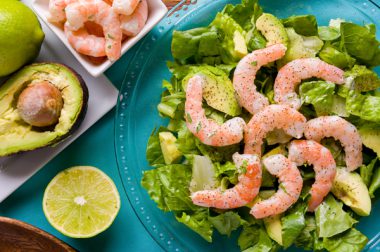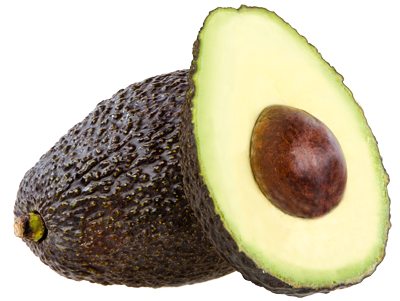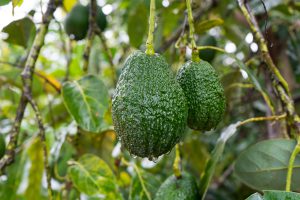Recipes we love
See all recipesMelon & avocado salad with pine nuts
The avocado is a nutritional treasure: in this recipe, paired with melon, high in provitamin A and f...
Avocado fondant
A delicious way of serving avocado to children and foodies alike, this rich and tasty recipe contain...
Salmon tartare with avocados
You can serve this tartare on a bed of baby spinach, which works very well with avocado. A cocktail ...
Health
benefits
A vegetable that contains fats is a rare thing !
Avocados are the exception to the rule about vegetables containing no fat. In fact, their fat content is quite significant, at 20% – although three-quarters of ,this is ‘good’ unsaturated fatty acids (notably for the heart and blood vessels. That means that avocados are a healthy exception!
Avocados are also:
- a source of fiber (for promoting good bowel function, satiety and healthy gut microbiota)
- a source of vitamin E (an antioxidant)
- a source of potassium (for the nervous system, muscular function, and blood pressure)
- rich in vitamin B9 (for cellular renewal, immunity and fighting fatigue, particularly important for pregnant women for fetal development)
Nutritional
composition
When is the right
time to eat them?
All year!
However, November and December are the best time to eat avocados, when they are fully mature.
Vegetable patch or
urban balcony?
Avocados are perennials that grow well in well-drained soil rich in humus, in a sunny spot.
To learn everything you need to know about growing avocados, read the page on growing advice.
Choosing and
storing avocados
Choose your avocados well :
Don’t rely on its color, which varies depending on the variety, but on its resistance to touch: the harder it is, the less ripe it is.
Properly store your avocados :
- Store them in the vegetable drawer of your refrigerator for two to three days.
- If they are too firm, allow them to ripen at room temperature alongside an apple or a banana, which emit ethylene, a gas that promotes ripening.
Consume them rapidly after they are ripe, placing them in the refrigerator (12°C) right before eating them to add a bit of freshness to the dish!
Recommendation: Squeeze lemon juice onto the flesh of a cut avocado. Otherwise it will turn brown when exposed to the air (due to a normal oxidation reaction). The vitamin C in the lemon juice reduces the discoloration while also adding a tart flavor.
Anti-waste tips
If your avocados a little overripe, don’t throw them away! You can still make guacamole or another dip for crudités or breadsticks… or mix the flesh with garlic, olive oil, pine nuts and basil to make a creamy pesto that is perfect with pasta!
What is the environmental impact?
The Product Environmental Footprint (PEF), a score established by Agribalyse*, tells us more! It takes account of all the phases in a vegetable’s life cycle: how it’s grown, the impact of its transport, the impact of its processing, and so on. The lower the score, the lower the environmental impact.
- Avocado, raw: 0.55
- Steak, raw: 2.77
*Data taken from the Agribalyse database, which gives the environmental score of foodstuffs. This unique score is the average of 16 indicators, calculated using the European methodology PEF. It is not the same as an environmental label or “eco-score”.
CO2 equivalent: for 100g of raw avocado: 0.275 kg of CO2 eq, which is the same as 8.1 g of raw steak or driving 1100 m by car
Tips and
tricks
How to prepare avocados
Avocados are ideally eaten raw and do not stand up well to cooking, which distorts their taste. However, you can briefly grill an avocado.
Once peeled, avocados can be prepared any way: in cubes, blended, cut into thin slices, puréed, or even juiced or in a smoothie!
Avocados go well with…
This versatile vegetable goes perfectly with crustaceans (crab, shrimp, lobster, etc.), fish (tuna, cod, scad, etc.), aromatic herbs (cilantro, basil, mint, etc.), spices (curry, hot pepper, etc.), garlic, onion, fruit (apples, lemons, strawberries, etc.), or vegetables (radishes, tomatoes, etc.).
Try it out! Some chefs delicately combine it with…chocolate!
To eat an avocado without getting your hands dirty:
- roll the avocado between your hands for a few seconds to loosen the skin
- cut it in two around the pit
- pierce the pit with a pointed knife to easily remove it
- delicately loosen the flesh from the two sides with a spoon
- add lemon juice to prevent the flesh from turning brown and set aside
Did you know? Avocados are regularly used in the manufacture of cosmetic products, notably for their regenerative effects on the scalp and the skin.
Anti-waste tip: An idea to avoid throwing away an overripe or slightly damaged avocado: use it to nourish your skin or hair.
Can everyone
eat them?
Young children
As soon as your child turns 12 months old, you can add avocados to the menu.
They are a wonderful food for children, greatly appreciated because they are high in calories (a natural attraction for kids), high in ‘good’ fats (perfect for growth and brain development), smooth in texture, and neutral in taste.
Recommendation: For young children, avocados can easily be eaten with a spoon in purée form, for example as a mild guacamole.
Has your older child become picky? Remember that the more familiar children are with a food, the easier it will be for them to learn to like it and to willingly eat it. Provide many opportunities to eat it, even in small quantities!
Play around with what your child already likes to eat: for example, you can make a guacamole sandwich and add imitation crab, put avocado and tomatoes on a homemade hamburger, mix avocado cubes with cherry tomatoes, and shrimp on a kabob, or make a fruit salad with apples, kiwis, and avocado pieces.
And everyone else
The tender texture of avocados will make them a particular hit with elderly people. They also provide a good dose of fiber, vitamins, and good unsaturated fatty acids, great for brain health. This is true for people of all ages!
See plenty of other tips for encouraging children to eat vegetables

Green or
black?
Origins
The fruit of the avocado tree, which is in the same family as the laurel and cinnamon trees, the avocado (Persea gratissima) is native to Central America, more precisely to Mexico, where the Aztecs and the Maya already were consuming it 8000 years ago!
Varieties
Today, there are over ten avocado varieties available in stores, in particular:
- Green: the Fuerte, a green, pear-shaped avocado with smooth and shiny skin
- Black: Hass avocados, with rough black or bluish-brown skin. The latter represents over 80% of world production.
Avocados are mainly grown in the West Indies, Africa, Australia, Israel, Mexico, Peru, the United States, Indonesia, Kenya, Spain, and Corsica.



 Radishes
Radishes  Garlic
Garlic  Vegetable garden: growing artichoke
Vegetable garden: growing artichoke 










